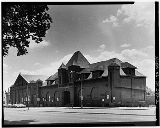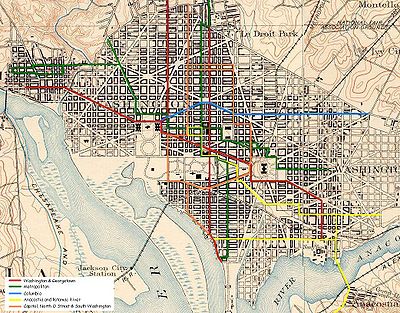
Columbia Railway
Encyclopedia

Seat Pleasant, Maryland
Seat Pleasant is an incorporated city in Prince George's County, Maryland, United States immediately east of Washington D.C. The population was 4,885 at the 2000 census. Two state highways run through it — Maryland Route 704 and Maryland Route 214...
and Kenilworth in 1898. In the late 19th Century it was purchased by the Washington Traction and Electric Company and on February 4, 1902, became a part of the Washington Railway and Electric Company
Washington Railway and Electric Company
The Washington Railway and Electric Company was the larger of the two major street railway companies in Washington, D.C., the capital of the United States, until 1933. At that time, it was merged with its main competitor, the Capital Traction Company, to form the Capital Transit Company...
.
Origins
Chartered by Congress on May 24, 1870, and beginning operations the same year, the Columbia Railway Company was the city’s third horse car operator. Its route began at 15th Street and New York Avenue NWNew York Avenue (Washington, D.C.)
New York Avenue is one of the diagonal avenues radiating from the White House in Washington, D.C. It is a major east-west route in the city's Northwest and Northeast quadrants and connects downtown with points east and north of the city via Cheverly, Maryland, the John Hanson Highway and the...
, where it intersected the Washington and Georgetown
Washington and Georgetown Railroad
The Washington and Georgetown Railroad Company was the first streetcar company to operate in Washington, D.C. It was incorporated and started operations in 1862, running from Georgetown to the Navy Yard. Two additional lines ran on 7th Street NW/SW and 14th Street NW. In 1890 it switched from...
line, and continued east on New York Avenue NW to K Street NW
K Street (Washington, D.C.)
K Street is a major thoroughfare in the United States capital of Washington, D.C. known as a center for numerous think tanks, lobbyists, and advocacy groups.-Location:...
(at that time the location of the Northern Liberties Market, now Mt. Vernon Square). From K Street NW, it went south on Massachusetts Avenue NW
Massachusetts Avenue (Washington, D.C.)
Massachusetts Avenue is a major diagonal transverse road in Washington, D.C., and the Massachusetts Avenue Historic District is a historic district that includes part of it....
to H Street NW
H Street (Washington, D.C.)
H Street is an east-west street in Washington, D.C.. It is also used as an alternate name for the Near Northeast neighborhood, as H Street is the neighborhood's main commercial strip.-History:...
and all the way across H Street to the city boundary at 15th Street NE, a round trip distance of five miles. The line began as a single track with turnouts
Railroad switch
A railroad switch, turnout or [set of] points is a mechanical installation enabling railway trains to be guided from one track to another at a railway junction....
for cars to pass, but a double track was added by 1872. The company built a car barn and stable
Stable
A stable is a building in which livestock, especially horses, are kept. It most commonly means a building that is divided into separate stalls for individual animals...
on the east side of 15th Street just south of H Street at the eastern end of the line. By 1883, the company was running 15 cars, each making 11 trips daily. There were 52 horses in the stable and 34 employees. The Columbia originally ran one-man one horse cars called "bobtails" but these were so unpopular that it led to a rider's strike
Boycott
A boycott is an act of voluntarily abstaining from using, buying, or dealing with a person, organization, or country as an expression of protest, usually for political reasons...
. As a result Congress
United States Congress
The United States Congress is the bicameral legislature of the federal government of the United States, consisting of the Senate and the House of Representatives. The Congress meets in the United States Capitol in Washington, D.C....
banned the short cars in 1892.
Switch to Mechanical and Electrical Power

Horse
The horse is one of two extant subspecies of Equus ferus, or the wild horse. It is a single-hooved mammal belonging to the taxonomic family Equidae. The horse has evolved over the past 45 to 55 million years from a small multi-toed creature into the large, single-toed animal of today...
power to underground cable
Cable car (railway)
A cable car or cable railway is a mass transit system using rail cars that are hauled by a continuously moving cable running at a constant speed. Individual cars stop and start by releasing and gripping this cable as required...
or to electricity
Electricity
Electricity is a general term encompassing a variety of phenomena resulting from the presence and flow of electric charge. These include many easily recognizable phenomena, such as lightning, static electricity, and the flow of electrical current in an electrical wire...
provided by battery
Battery (electricity)
An electrical battery is one or more electrochemical cells that convert stored chemical energy into electrical energy. Since the invention of the first battery in 1800 by Alessandro Volta and especially since the technically improved Daniell cell in 1836, batteries have become a common power...
or underground wire
Wire
A wire is a single, usually cylindrical, flexible strand or rod of metal. Wires are used to bear mechanical loads and to carry electricity and telecommunications signals. Wire is commonly formed by drawing the metal through a hole in a die or draw plate. Standard sizes are determined by various...
and in 1890 companies were authorized to sell stock
Stock
The capital stock of a business entity represents the original capital paid into or invested in the business by its founders. It serves as a security for the creditors of a business since it cannot be withdrawn to the detriment of the creditors...
to pay for the upgrades - provided they did not involve overhead wires. In 1892, one-horse cars were banned within the city, and by 1894 Congress began requiring companies to switch to something other than horse power while continuing to disallow overhead lines within the city.
In order to comply with the new rules, the Columbia decided to try a cable system, the last cable car system built in the United States
United States
The United States of America is a federal constitutional republic comprising fifty states and a federal district...
. They built a new cable car barn and began operating the system on March 9, 1895, but it wasn't long before it became clear that the underground electrical system was superior, so it abandoned cable cars and switched to electrical power on July 22, 1899. The last cable car in the city ran the next day.
Using electricity from the power plant built to power its cable operation, the Columbia won permission in 1898 to build a line east along Benning Road NE. Since this route was outside the city as defined at the time, overhead wires could be used to provide electric power. The line split on the east side of the Anacostia. One branch ran to Kenilworth
Kenilworth, Washington, D.C.
Kenilworth is a residential neighborhood in Northeast Washington, D.C., located on the eastern bank of the Anacostia River and just inside the D.C.-Maryland border. A large public housing complex, Kenilworth Courts, dominates the area...
, and the other connected at Seat Pleasant
Seat Pleasant, Maryland
Seat Pleasant is an incorporated city in Prince George's County, Maryland, United States immediately east of Washington D.C. The population was 4,885 at the 2000 census. Two state highways run through it — Maryland Route 704 and Maryland Route 214...
with the terminus of the steam-powered
Steam locomotive
A steam locomotive is a railway locomotive that produces its power through a steam engine. These locomotives are fueled by burning some combustible material, usually coal, wood or oil, to produce steam in a boiler, which drives the steam engine...
Chesapeake Beach Railway
Chesapeake Beach Railway
The Chesapeake Beach Railway , now defunct, was an American railroad of southern Maryland and Washington, DC built in the 19th century. The CBR ran 27.629 miles from Washington, D.C. on tracks formerly owned by the Southern Maryland Railroad and then on its own single track through Maryland farm...
.
The End of the Line
Between the years 1896 and 1899, three businessmen purchased controlling interests in several streetcar companies including the Columbia Railway Company. They incorporated the Washington Traction and Electric Company on June 5, 1899 as a holding companyHolding company
A holding company is a company or firm that owns other companies' outstanding stock. It usually refers to a company which does not produce goods or services itself; rather, its purpose is to own shares of other companies. Holding companies allow the reduction of risk for the owners and can allow...
for these interests. But the holding company had borrowed too heavily and paid too much for the subsidiaries and was quickly in financial trouble. Because of this, Congress - on June 5, 1900 - authorized the Washington and Great Falls to acquire the stock of any and all of the railways and power companies
Electrical power industry
The electric power industry provides the production and delivery of electric energy, often known as power, or electricity, in sufficient quantities to areas that need electricity through a grid connection. The grid distributes electrical energy to customers...
owned by Washington Traction. When Washington Traction defaulted
Default (finance)
In finance, default occurs when a debtor has not met his or her legal obligations according to the debt contract, e.g. has not made a scheduled payment, or has violated a loan covenant of the debt contract. A default is the failure to pay back a loan. Default may occur if the debtor is either...
on its loans on June 1, 1901 Washington and Great Falls moved in to take its place. On February 4, 1902, Washington and Great Falls changed its named to the Washington Railway and Electric Company
Washington Railway and Electric Company
The Washington Railway and Electric Company was the larger of the two major street railway companies in Washington, D.C., the capital of the United States, until 1933. At that time, it was merged with its main competitor, the Capital Traction Company, to form the Capital Transit Company...
, reincorporated as a holding company and exchanged stock in Washington Traction and Electric one for one for stock in the new company (at a discounted rate). This was the end of the Columbia Railway Company.

